Microstructure of Joints Processed by Ultrasonic Consolidation of Nickel Sheets
Abstract
:1. Introduction
2. Materials and Methods
3. Results and Discussion
4. Conclusions
Author Contributions
Funding
Data Availability Statement
Acknowledgments
Conflicts of Interest
References
- Willrich, H.O. Application of ultrasonic waves. Weld J. 1950, 18, 61–66. [Google Scholar]
- Lewis, W.J.; Antonevich, J.N.; Monroe, R.E.; Rieppel, P.J. Fundamental Studies on the Mechanism of Ultrasonic Welding; Technical Report; Wright-Patterson Air Force Base: Dayton, OH, USA, 1960. [Google Scholar]
- Matheny, M.P.; Graff, K.F. Ultrasonic welding of metals. In Power Ultrasonics-Applications of High-Intensity Ultrasound; GallegoJuárez, J.A., Graff, K.F., Eds.; Woodhead: Cambridge, UK, 2015; pp. 259–293. [Google Scholar]
- Ultrasonic Metal Welding. Available online: www.SonobondUltrasonics.com (accessed on 19 September 2022).
- White, D. Ultrasonic Object Consolidation. U.S. Patent 6,519,500, 23 March 2000. [Google Scholar]
- Su, Z.; Zhu, Z.; Zhang, Y.; Zhang, H.; Xiao, Q. Recrystallization Behavior of a Pure Cu Connection Interface with Ultrasonic Welding. Metals 2021, 11, 61. [Google Scholar] [CrossRef]
- Hehr, A.; Norfolk, M. A comprehensive review of ultrasonic additive manufacturing. Rapid. Proto. J. 2019, 26, 445–458. [Google Scholar] [CrossRef]
- Becker, M.; Balle, F. Multi-Spot Ultrasonic Welding of Aluminum to Steel Sheets: Process and Fracture Analysis. Metals 2021, 11, 779. [Google Scholar] [CrossRef]
- Lee, S.S.; Kim, T.H.; Hu, S.J.; Cai, W.W.; Li, J.; Abell, J.A. Characterization of joint quality in ultrasonic welding of battery tabs. J. Manuf. Sci. Eng. 2012, 135, 249–261. [Google Scholar] [CrossRef]
- Bakkar, A.; Ataya, S.; Badr, O. Failure analysis of heat exchanger tubes of Ni-200 alloy in a titanium tetrachloride vaporizer. J. Petrol. Min. Eng. 2020, 22, 21–25. [Google Scholar] [CrossRef]
- Sanga, B.; Wattal, R.; Nagesh, D. Mechanism of joint formation and characteristics of interface in ultrasonic welding: Literature Review. Period. Eng. Nat. Sci. 2018, 6, 107–119. [Google Scholar] [CrossRef]
- Li, D. A review of microstructure evolution during ultrasonic additive manufacturing. Int. J. Adv. Manuf. Technol. 2021, 113, 1–19. [Google Scholar] [CrossRef]
- Ni, Z.L.; Ye, F.X. Ultrasonic spot welding of aluminum alloys: A review. J. Manuf. Processes 2018, 35, 580–594. [Google Scholar] [CrossRef]
- Schick, D.E.; Hahnlen, R.M.; Dehoff, R.; Collins, P.; Babu, S.S.; Dapino, M.J.; Lippold, J.C. Microstructural characterization of bonding interfaces in aluminum 3003 blocks fabricated by ultrasonic additive manufacturing. Weld J. 2010, 89, 105–115. [Google Scholar]
- Sojiphan, K.; Sriraman, M.R.; Babu, S.S. Stability of Microstructure in Al3003 Builds made by Very High Power Ultrasonic Additive Manufacturing. In Proceedings of the International Sold Freeform Fabrication Symposium—An Additive Manufacturing Conference, Austin, TX, USA, 9–11 August 2010; pp. 362–372. [Google Scholar]
- Wolcott, P.; Hehr, A.; Pawlowski, C.; Dapino, M. Process improvements and characterization of ultrasonic additive manufactured structures. J. Mater. Process. Technol. 2016, 233, 44–52. [Google Scholar] [CrossRef] [Green Version]
- Gussev, M.N.; Sridharan, N.; Norfolk, M.; Terrani, K.A.; Babu, S.S. Effect of post weld heat treatment on the 6061 aluminum alloy produced by ultrasonic additive manufacturing. Mater. Sci. Eng. A 2017, 684, 606–616. [Google Scholar] [CrossRef]
- Gussev, M.N.; Sridharan, N.; Thompson, Z.; Terrani, K.A.; Babu, S.S. Influence of hot isostatic pressing on the performance of aluminum alloy fabricated by ultrasonic additive manufacturing. Scr. Mater. 2018, 145, 33–36. [Google Scholar] [CrossRef]
- Kuo, C.H.; Sridharan, N.; Han, T.; Dapino, M.J.; Babu, S.S. Ultrasonic additive manufacturing of 4130 steel using Ni interlayers. Sci. Technol. Weld. Join. 2019, 24, 382–390. [Google Scholar] [CrossRef]
- Friel, R.J.; Johnson, K.E.; Dickens, P.M.; Harris, R.A. The effect of interface topography for Ultrasonic Consolidation of aluminium. Mater. Sci. Eng. A 2010, 527, 4474–4483. [Google Scholar] [CrossRef] [Green Version]
- Feng, M.N.; Zhen, L. Interface morphology and microstructure of high-power ultrasonic spot welded Mg/Al dissimilar joint. Sci. Technol. Weld. Join. 2019, 24, 63–78. [Google Scholar] [CrossRef]
- Li, D.; Soar, R. Influence of sonotrode texture on the performance of an ultrasonic consolidation machine and the interfacial bond strength. J. Mater. Process. Technol. 2009, 209, 1627–1634. [Google Scholar] [CrossRef]
- Kong, C.Y.; Soar, R.C.; Dickens, P.M. Optimum process parameters for ultrasonic consolidation of 3003 aluminium. J. Mater. Process. Technol. 2004, 146, 181–187. [Google Scholar] [CrossRef]
- Li, H.; Cao, B. Effects of welding pressure on high-power ultrasonic spot welding of Cu/Al dissimilar metals. J. Manuf. Processes 2019, 46, 194–203. [Google Scholar] [CrossRef]
- Janaki Ram, G.D.; Yang, Y.; Stucker, B.E. Effect of process parameters on bond formation during ultrasonic consolidation of aluminum alloy 3003. J. Manuf. Syst. 2006, 25, 221–238. [Google Scholar] [CrossRef]
- Kulakov, M.; Rack, H.J. Control of 3003-H18 aluminum ultrasonic consolidation. J. Eng. Mater. Technol. 2009, 131, 0210061. [Google Scholar] [CrossRef]
- Hopkins, C.; Fernandez, S.; Dapino, M. Statistical characterization of ultrasonic additive manufacturing Ti/Al composites. J. Eng. Mater. Technol. 2010, 132, 041006. [Google Scholar] [CrossRef]
- Rousseau, J.-N.; Bois-Brochu, A.; Giguère, N.; Blais, C. Study of ultrasonic additive manufacturing and its utilization for the production of aluminum components made of alloys of the AA5XXX series. Int. J. Adv. Manuf. Technol. 2022, 119, 7983–8002. [Google Scholar] [CrossRef]
- Mariani, E.; Ghassemieh, E. Microstructure evolution of 6061 O Al alloy during ultrasonic consolidation: An insight from electron backscatter diffraction. Acta Mater. 2010, 58, 2492–2503. [Google Scholar] [CrossRef]
- Dehoff, R.; Babu, S.S. Characterization of interfacial microstructures in 3003 aluminum alloy blocks fabricated by ultrasonic additive manufacturing. Acta Mater. 2010, 58, 4305–4315. [Google Scholar] [CrossRef]
- Fujii, H.T.; Sriraman, M.R.; Babu, S.S. Quantitative evaluation of bulk and interface microstructures in Al-3003 alloy builds made by very high power ultrasonic additive manufacturing. Metall. Mater. Trans. A 2011, 42A, 4045–4055. [Google Scholar] [CrossRef]
- Shimizu, S.; Fujii, H.T.; Sato, Y.S.; Kokawa, H.; Sriraman, M.R.; Babu, S.S. Mechanism of weld formation during very-high-power ultrasonic additive manufacturing of Al alloy 6061. Acta Mater. 2014, 74, 234–243. [Google Scholar] [CrossRef]
- Fujii, H.T.; Shimizu, S.; Sato, Y.S.; Kokawa, H. High-strain-rate deformation in ultrasonic additive manufacturing. Scr. Mater. 2017, 135, 125–129. [Google Scholar] [CrossRef]
- Johnson, K.E. Interlaminar Subgrain Refinement in Ultrasonic Consolidation. Ph.D. Thesis, Loughborough University, Loughborough, UK, 2008. Available online: https://digitalcommons.olivet.edu/engn_facp/1 (accessed on 19 September 2022).
- Sridharan, N.; Wolcott, P.; Dapino, M.; Babu, S.S. Microstructure and texture evolution in aluminum and commercially pure titanium dissimilar welds fabricated using ultrasonic additive manufacturing. Scr. Mater. 2016, 117, 1–5. [Google Scholar] [CrossRef]
- Lin, J.-Y.; Nambu, S.; Koseki, T. Evolution of bonding interface during ultrasonic welding between steel and aluminium alloy. Sci. Technol. Weld. Join. 2019, 24, 83–91. [Google Scholar] [CrossRef]
- Wolcott, P.J.; Sridharan, N.; Babu, S.S.; Miriyev, A.; Frage, N.; Dapino, M.J. Characterisation of Al–Ti dissimilar material joints fabricated using ultrasonic additive manufacturing. Sci. Technol. Weld. Join. 2016, 21, 114–123. [Google Scholar] [CrossRef]
- Sriraman, M.R.; Babu, S.S.; Short, M. Bonding characteristics during very high power ultrasonic additive manufacturing of copper. Scr. Mater. 2010, 62, 560–563. [Google Scholar] [CrossRef]
- Obielodan, J.; Ceylan, A.; Murr, L.; Stucker, B. Multi-material bonding in ultrasonic consolidation. Rapid. Prototyp. J. 2010, 16, 180–188. [Google Scholar] [CrossRef]
- Sriraman, M.R.; Gonser, M.; Fujii, H.T.; Babu, S.S.; Bloss, M. Thermal transients during processing of materials by very high power ultrasonic additive manufacturing. J. Mater. Process Technol. 2011, 211, 1650–1657. [Google Scholar] [CrossRef]
- Janaki Ram, G.D.; Yang, Y.; Nylander, C.; Aydelotte, B.; Stucker, B.E.; Adams, B.L. Interface microstructures and bond formation in ultrasonic consolidation. In Proceedings of the International Solid Freeform Fabrication Symposium, Austin, TX, USA, 6–8 August 2007. [Google Scholar] [CrossRef]
- Shayakhmetova, E.R.; Murzinova, M.A.; Nazarov, A.A. Ultrasonic welding of nickel with coarse and ultrafine grained structures. Metals 2021, 11, 1800. [Google Scholar] [CrossRef]
- Gurao, N.P.; Satyam, S. Generalized scaling of misorientation angle distributions at meso-scale in deformed materials. Sci. Rep. 2014, 4, 5641. [Google Scholar] [CrossRef] [Green Version]
- Mukhametgalina, A.A.; Murzinova, M.A.; Nazarov, A.A. Ultrasonic spot welded, CP Ti/AA2024/CP Ti alloy joints. Lett. Mater. 2021, 11, 508–513. [Google Scholar] [CrossRef]
- Zhilyaev, A.P.; Shakhova, I.; Belyakov, A.; Kaibyshev, R.; Langdon, T.G. Wear resistance and electroconductivity in copper processed by severe plastic deformation. Wear 2013, 305, 89–99. [Google Scholar] [CrossRef]
- Lin, J.Y.; Nambu, S.; Koseki, T. Evolution of Bonding Interface during Ultrasonic Welding between Ni and Steels with Various Microstructure. ISIJ International 2020, 60, 330–336. [Google Scholar] [CrossRef] [Green Version]
- Schwartz, A.J.; Kumar, M.; Adams, B.L. Electron Backscatter Diffraction in Materials Science. In Mapping and Assessing Plastic Deformation Using EBSD; Brewer, L.N., Field, D.P., Merrima, C.C., Eds.; Springer Science: New York, NY, USA, 2009; pp. 251–276. [Google Scholar] [CrossRef]
- Wright, S.I.; Nowell, M.M.; Field, D.P. A Review of Strain Analysis Using Electron Backscatter Diffraction. Microsc. Microanal. 2011, 17, 316–329. [Google Scholar] [CrossRef]
- Li, C.; Tang, X.; Zhang, H.; Wang, X.; Deng, L.; Zhang, M.; Gong, P.; Jin, J. Ultrasonic and size effects on the rheological behavior of CoCrFeMnNi high-entropy alloy. J. All. Comp. 2022, 913, 165238. [Google Scholar] [CrossRef]
- Hall, E.O. Deformation and ageing of mild steel: III Discussion of Results. Proc. Phys. Soc. 1951, 64, 747–753. [Google Scholar] [CrossRef]
- Petch, N.J. The cleavage strength of polycrystals. J. Iron. Steel. Inst. 1953, 174, 25–28. [Google Scholar]
- Nazarov, A.A. On the pile-up model of the grain size-yield stress relation for nanocrystals. Scr. Mater. 1996, 34, 697–701. [Google Scholar] [CrossRef]
- Thompson, A.W. Substructure Strengthening Mechanisms. Metall. Trans. 1977, 8A, 833–842. [Google Scholar] [CrossRef]
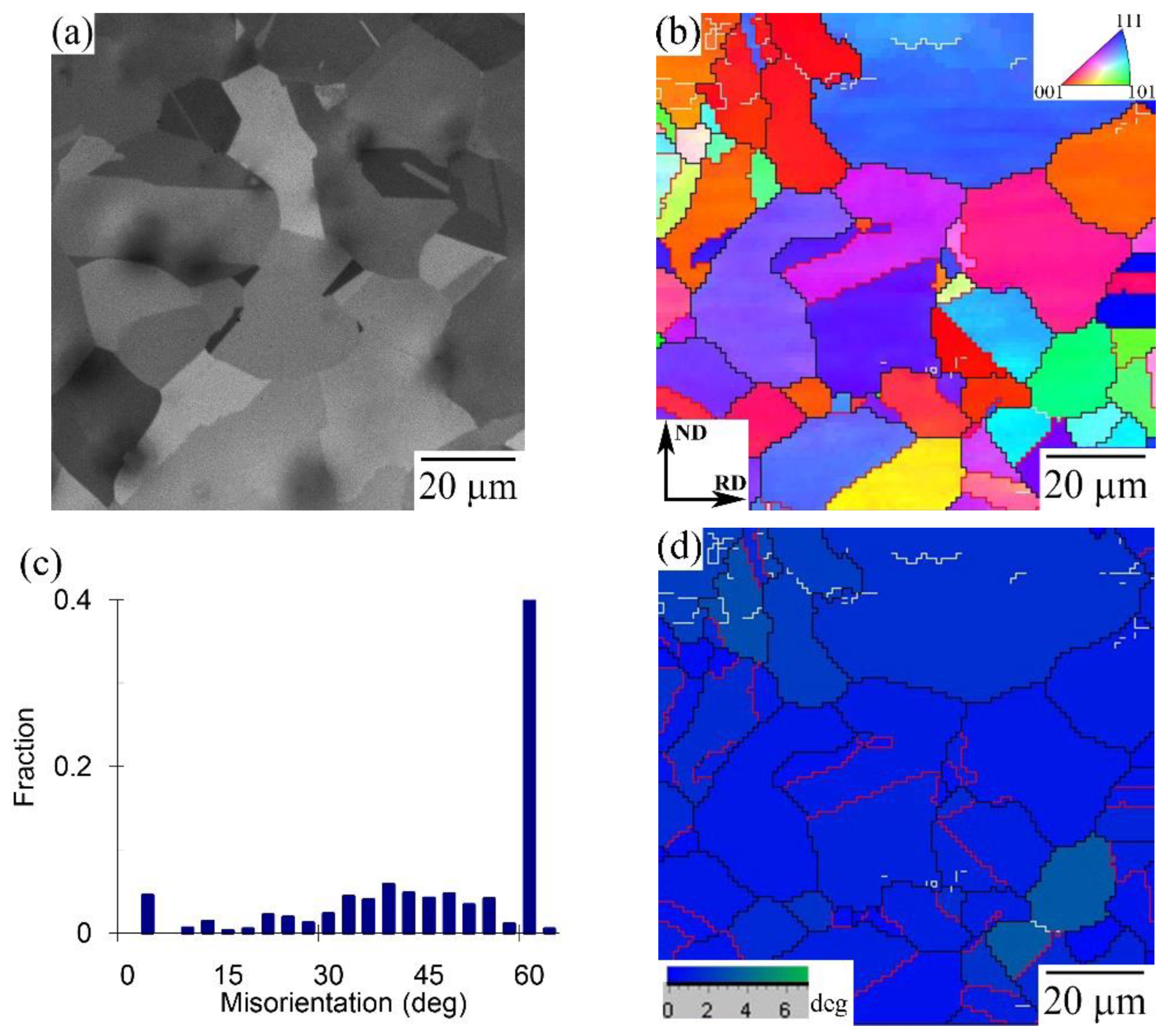
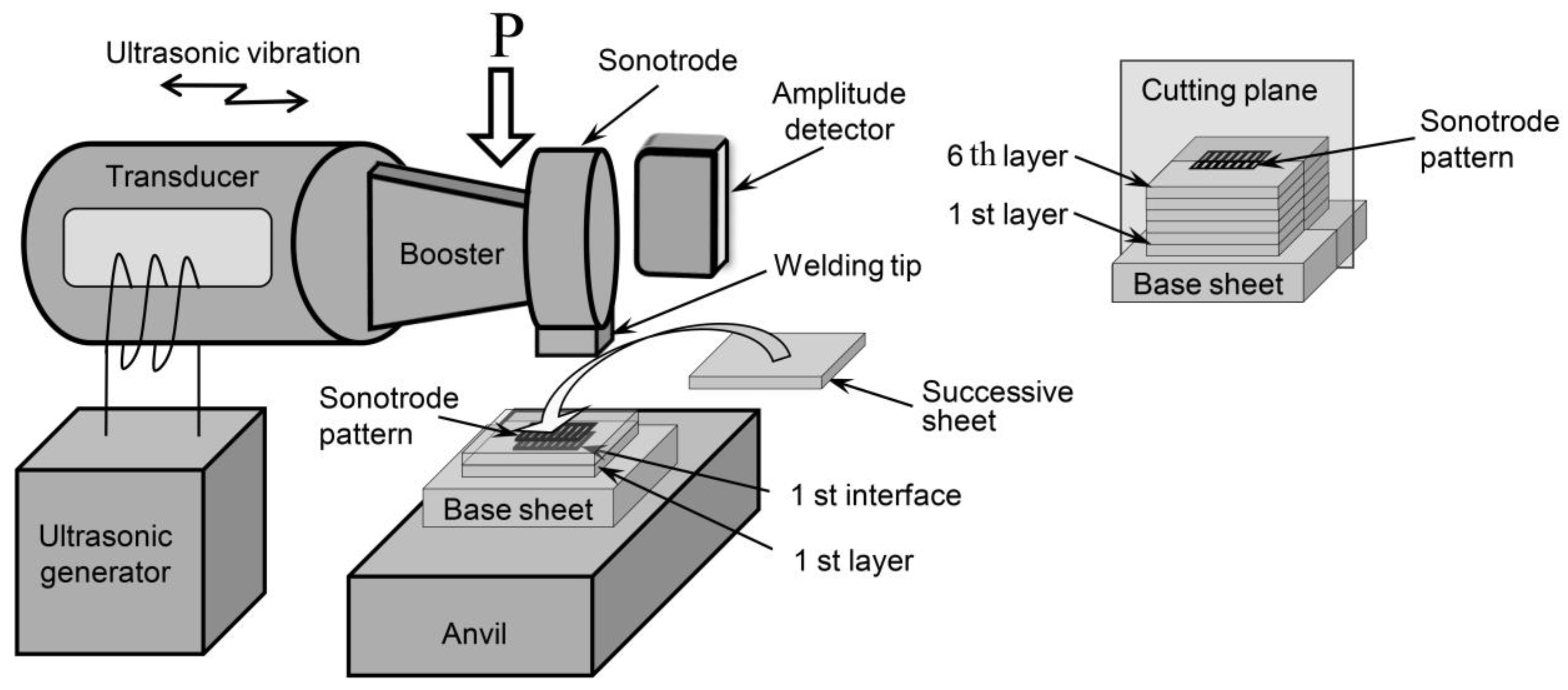
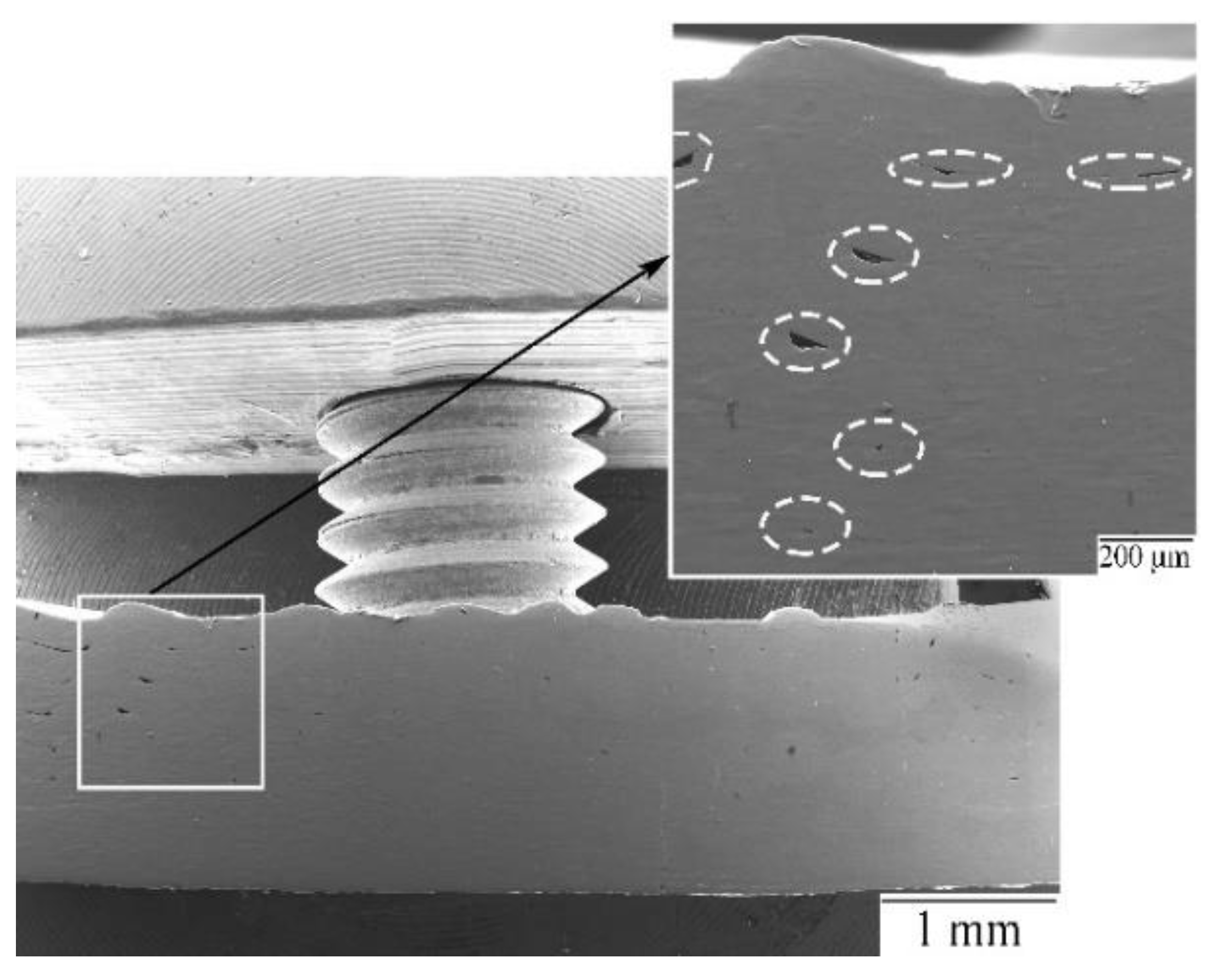
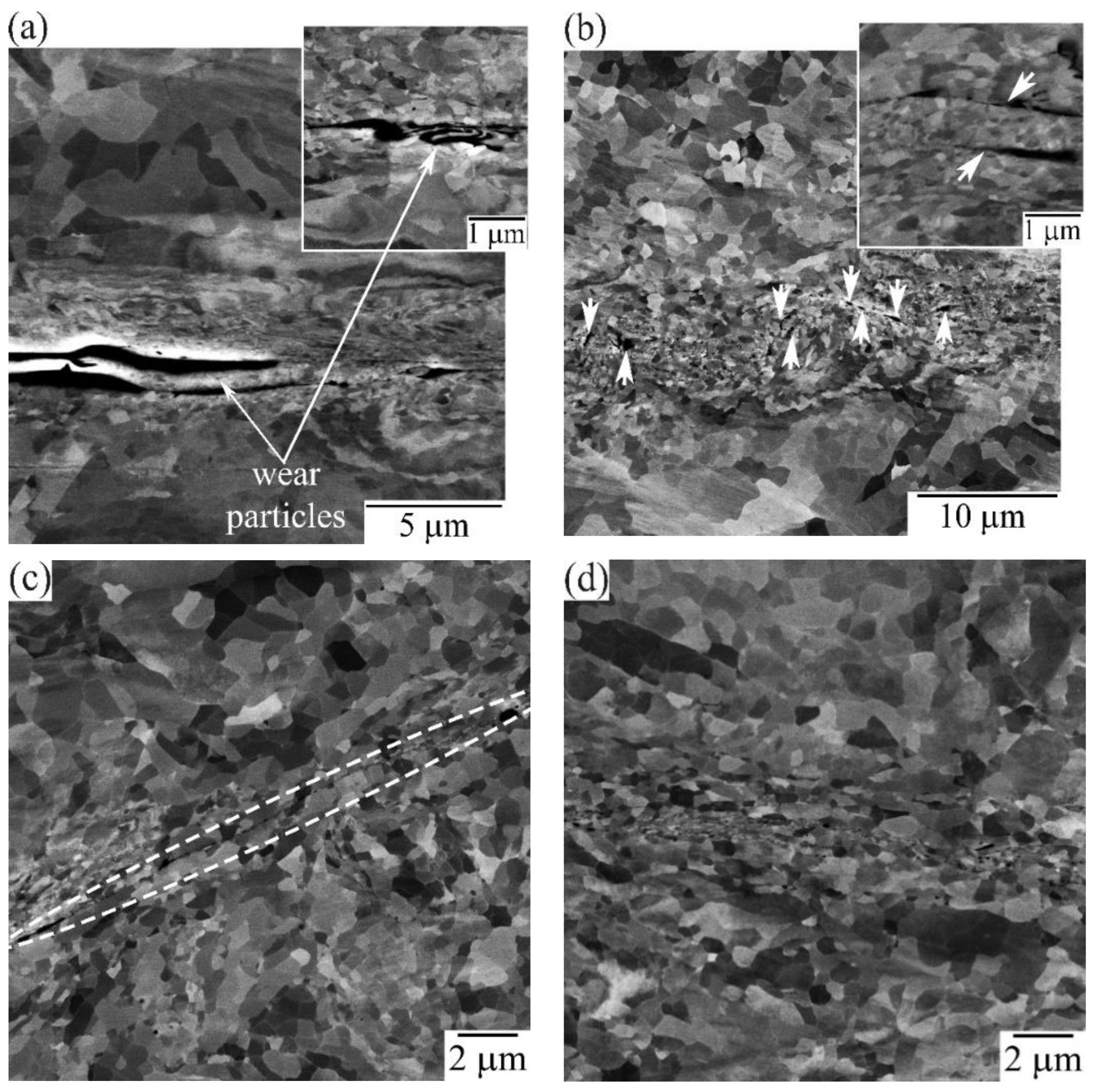

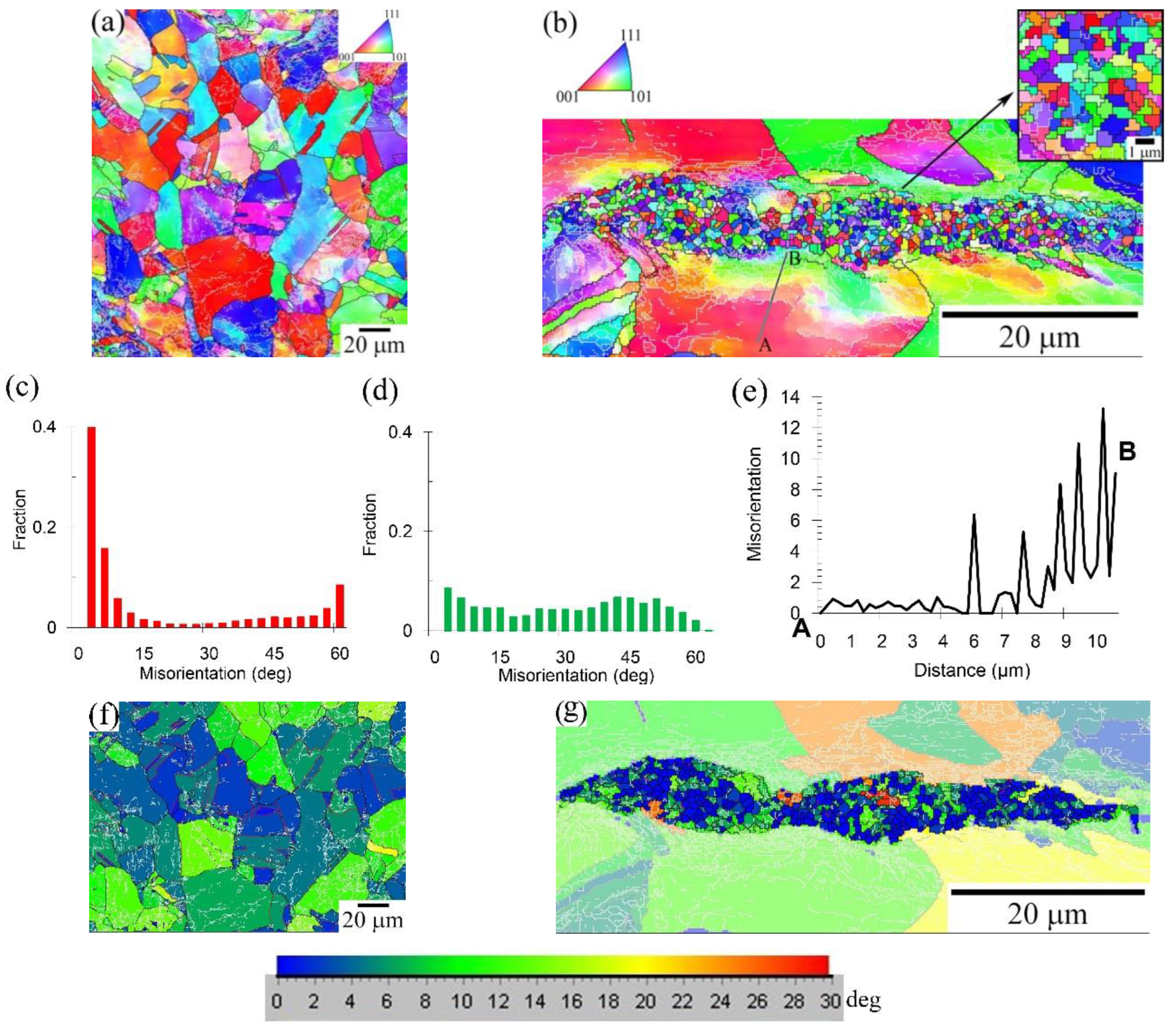
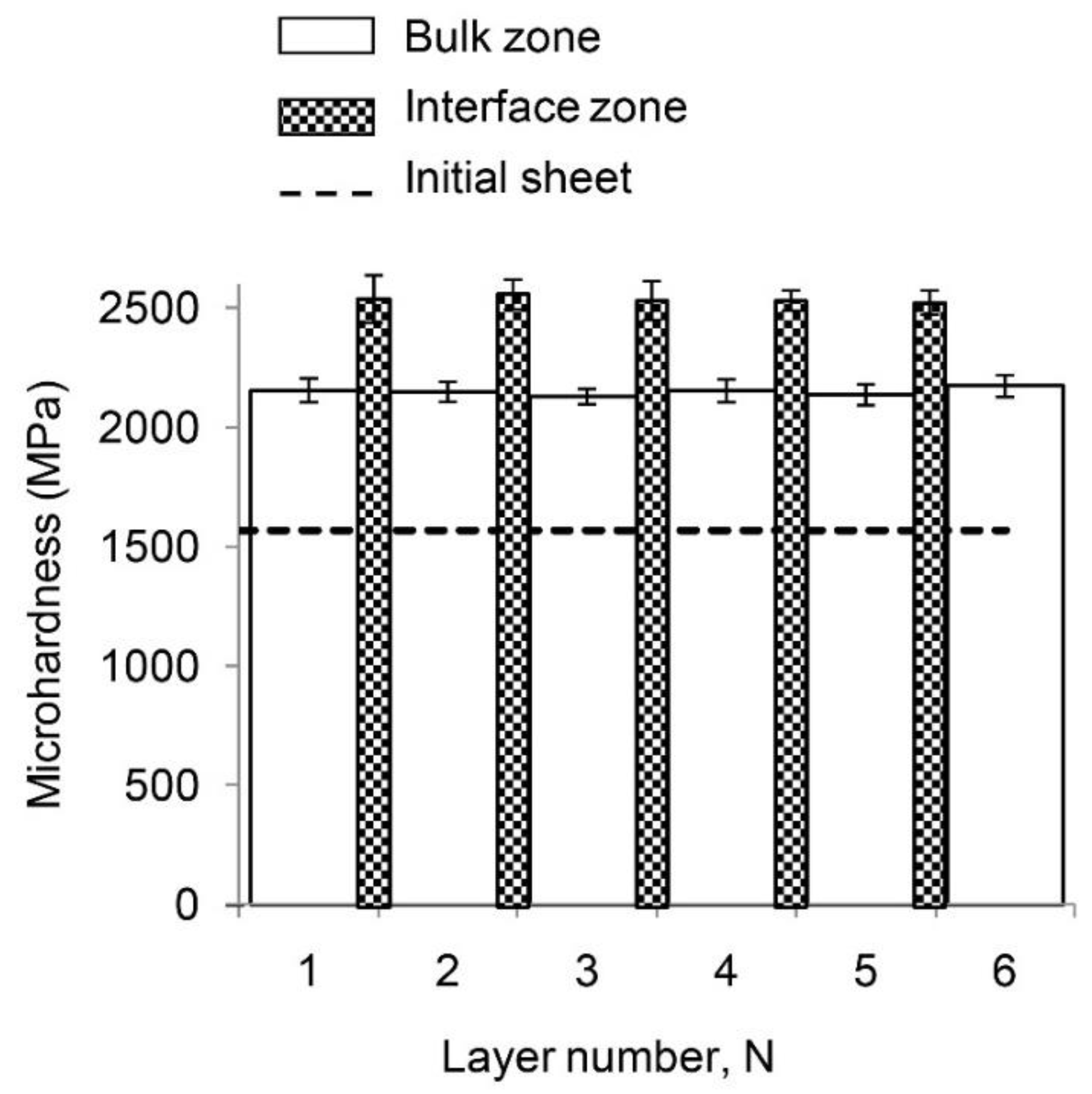
Publisher’s Note: MDPI stays neutral with regard to jurisdictional claims in published maps and institutional affiliations. |
© 2022 by the authors. Licensee MDPI, Basel, Switzerland. This article is an open access article distributed under the terms and conditions of the Creative Commons Attribution (CC BY) license (https://creativecommons.org/licenses/by/4.0/).
Share and Cite
Shayakhmetova, E.R.; Murzinova, M.A.; Zadorozhniy, V.S.; Nazarov, A.A. Microstructure of Joints Processed by Ultrasonic Consolidation of Nickel Sheets. Metals 2022, 12, 1865. https://doi.org/10.3390/met12111865
Shayakhmetova ER, Murzinova MA, Zadorozhniy VS, Nazarov AA. Microstructure of Joints Processed by Ultrasonic Consolidation of Nickel Sheets. Metals. 2022; 12(11):1865. https://doi.org/10.3390/met12111865
Chicago/Turabian StyleShayakhmetova, Elvina R., Mariya A. Murzinova, Vasiliy S. Zadorozhniy, and Ayrat A. Nazarov. 2022. "Microstructure of Joints Processed by Ultrasonic Consolidation of Nickel Sheets" Metals 12, no. 11: 1865. https://doi.org/10.3390/met12111865





